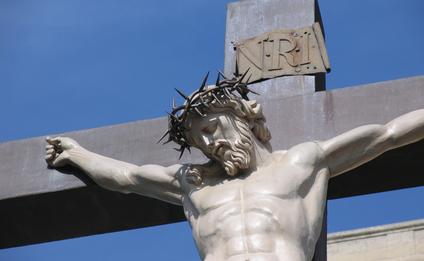The Stations of the Cross
"Rising very early before dawn, he left and went off to a deserted place, where he prayed."Mark 1:35

'The Stations of the Cross are a devotion. Thus, they are not required but they are perhaps one of the most common devotions done during Lent. Almost all Catholic Churches have the Stations of the Cross, generally on the side walls. Typically, they are inside the Church and are a image depicting the Station of the Cross. Each Station depicts an action in the final hours of Jesus’ life, His passion and death.
To understand why we do Stations of the Cross I offer the following on the historical development of the practice.
In Apostolic Times there was a tradition that Mary, Mother of Jesus would walk the streets of Jerusalem meditating upon Jesus’ passion. This remains the purpose of the Stations of the Cross today. We pray the Stations of the Cross to help us share in the sufferings of the Christ on Good Friday.
In the Fifth Century, according to St. Jerome, we know that pilgrims coming to Jerusalem made the Stations of the Cross. There is also evidence that they were found in a few churches in Europe. Pilgrimages to the Holy Land were a common penance.
In the Thirteenth Century, the Franciscans became the custodians of the Holy Land. They actively promoted the Stations of the Cross for pilgrims. Then, the Franciscans began to erect Stations outside the Holy Land.
In 1686, Pope Innocent XI granted the Franciscans permission to erect the Stations in all their churches with the same spiritual benefit as for those making the pilgrimage to Jerusalem. Then, in 1726, Pope Benedict XIII extended the spiritual benefits to all. Originally the number of stations varied but in 1731 the number of Stations was fixed at Fourteen. Finally, in 1862, all bishops were given the right to erect Stations of the Cross in all their churches.
Here is a table listing the fourteen stations. Some versions add a fifteenth station, the Resurrection. The official number of stations remains at fourteen. Fourteen is the number of generations in the genealogy of Jesus from Abraham to David, David to the Exile, and from the Exile to Jesus as told in Matthew 1.
Scriptural References for the Stations of the Cross
1. Jesus is Condemned to Death
- Matthew 27:15-26
- Mark 15:6-15
- Luke 23:18-25
2. Jesus Accepts His Cross
- John 19:17
3. Jesus Falls the First Time
4. Jesus Meets His Mother
- John 19:25
5. Simon Helps Jesus Carry the Cross
- Matthew 27:32
- Mark 15:21
- Luke 23:26
6. Veronica Wipes Jesus' Face
7. Jesus Falls the Second Time
8. Jesus Consoles the Women of Jerusalem
- Luke 23:27-32
9. Jesus Falls the Third Time
10. Jesus is Stripped of His Garments
- Matthew 27:28, 31
11. Jesus is Nailed to the Cross
- Evidence of the nails found in the story of Doubting Thomas in John 20:24-29
12. Jesus Dies on the Cross
- Matthew 27:45-56
- Mark 15:33-41
- Luke 23:43-49
- John 19:28-30
13. Jesus is Taken Down From the Cross
14. Jesus is Laid in the Tomb
- Matthew 27:57-61
- Mark 15:42-47
- Luke 23:50-56
- John 19:38-42
It has been a custom in recent years for the pope to choose a person to write a new set of meditations to be used for Stations of the Cross on Good Friday in Rome. Here is a link to those meditations.
Bibliography For Stations of the Cross
G. Cyprian Alson.“The Way of the Cross” The Catholic Encyclopedia. http://www.newadvent.org/cathen/15569a.htm.
Ann Ball, A Handbook of Catholic Sacramentals. Our Sunday Visitor. Huntington, IN. 1991, pg 44-47.
Rev. Jovian P. Long, OFM. Dictionary of the Liturgy. Catholic Book Publishing. New York. 1989.
Other forms of liturgy, devotion, and prayer include:
- Liturgy of the Hours
- Eucharistic Adoration
- Stations of the Cross
- The Divine Mercy
- The Sacred Heart of Jesus
- Contemplative & Centering Prayer
- Lectio Divina
- The Rosary
Here are some video presentations by Fr. Jeff on prayer:
- We Profess, We Believe - A series of five presentations on the Creed
- Talking to God: A Conversation about Prayer (2014)
- Giving Our Hearts to God: What It Means to Pray (2021) - a three part series
